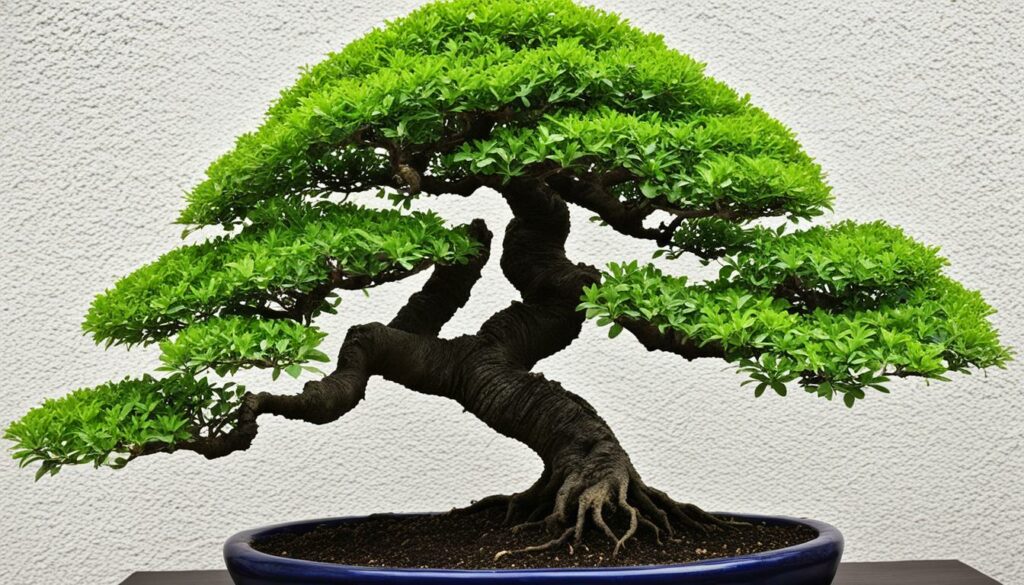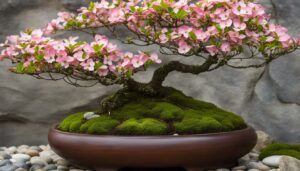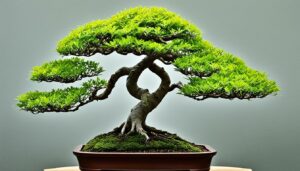Are you looking for a resilient and beautiful bonsai tree species? Look no further than the Chinese Elm. This species is known for its hardiness and ability to withstand a variety of conditions, making it a perfect choice for those new to bonsai cultivation.
In this section, we will explore the unique care essentials for Chinese Elm bonsai trees. From watering to pruning techniques, we will provide you with the knowledge you need to cultivate a thriving miniature masterpiece.
Key Takeaways:
- The Chinese Elm is a resilient bonsai tree species.
- Care essentials for Chinese Elm bonsai include proper watering, sunlight, pruning, and soil considerations.
- Pruning and shaping techniques can help you achieve traditional bonsai styles with your Chinese Elm.
- Common challenges, such as pests and diseases, can be overcome with proper care and attention.
- The aesthetic display of your Chinese Elm bonsai is important and should be considered when choosing pots and display stands.
Understanding the Chinese Elm (Ulmus parvifolia)
If you are looking for a bonsai tree species that is both beautiful and tough, the Chinese Elm (Ulmus parvifolia) is an excellent choice. This species is native to China, Korea, and Japan and has been a popular choice among bonsai enthusiasts for many years. The Chinese Elm is also known as the Lacebark Elm and has distinctive bark that ranges in color from green, gray, brown, to orange.
The Chinese Elm is a deciduous tree that boasts small, serrated leaves and beautiful, delicate flowers that bloom during the summer months. When grown as a bonsai, the Chinese Elm’s leaves can be trained to grow much smaller, creating a more intricate and fascinating display of foliage. This species is also resilient and can tolerate a range of temperatures, making it ideal for beginners or those living in varying climates.
One of the unique characteristics of the Chinese Elm that makes it a standout bonsai tree species is its ability to exhibit two distinct growth patterns. When in its natural environment, the Chinese Elm tree grows tall and straight. However, when grown as a bonsai, it can be trained to display a more artistic and whimsical form, with curving branches and a twisted trunk.
The Chinese Elm is a true beauty and an excellent choice for bonsai enthusiasts looking for a species that combines toughness and grace.
The Benefits of Growing Chinese Elm as a Bonsai Tree
Growing Chinese Elm as a bonsai tree offers a host of benefits for enthusiasts. Firstly, its small size makes it perfect for indoor cultivation, and thus, it can be grown all year round. Secondly, unlike many other bonsai trees that require high levels of maintenance, the Chinese Elm is hardy and can tolerate periods of neglect. Finally, its unique and exciting growth patterns can make it a highly desirable addition to any collection.
The Significance of the Chinese Elm in Bonsai Cultivation
The Chinese Elm has a rich history in the art of bonsai cultivation. In Chinese culture, it is a symbol of strength and perseverance, and it has been used as an ornamental tree for centuries. In the world of bonsai cultivation, the Chinese Elm is widely regarded as one of the best species for beginners, thanks to its resilience and adaptability. Its stunning seasonal changes, ease of care, and gorgeous aesthetic have made it a firm favorite among bonsai enthusiasts worldwide.
Characteristics of the Chinese Elm (Ulmus parvifolia)
| Scientific Name | Ulmus parvifolia |
|---|---|
| Common Name | Chinese Elm, Lacebark Elm |
| Origin | China, Korea, Japan |
| Height | up to 60 feet |
| Leaves | small, serrated, deciduous |
| Flowers | delicate, summer blooms |
| Care Level | moderate |
| Special Characteristics | hardy and adaptable to varying climates, can exhibit two distinct growth patterns |
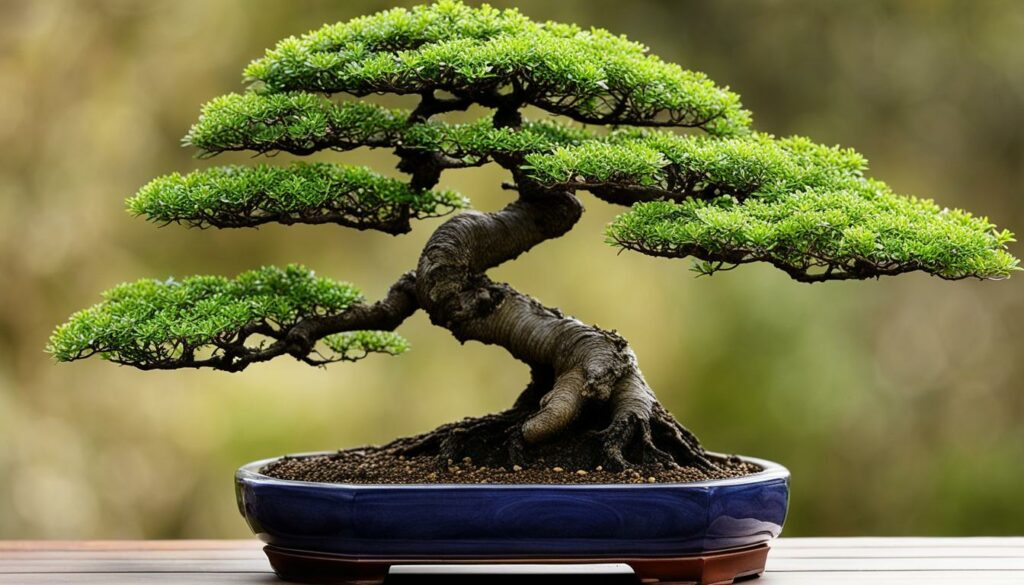
The Chinese Elm is a unique and fascinating bonsai tree species that offers both beauty and toughness to any enthusiast’s collection. Understanding its origins and characteristics is crucial in ensuring optimal growth and health, and knowing why it has been a favorite of bonsai enthusiasts for centuries can only increase your appreciation.
The Beauty of Deciduous Bonsai
Deciduous bonsai trees are a unique type of bonsai that undergo stunning seasonal changes. These trees lose their foliage in the fall, revealing its unique essence in the winter, bursting into new life during spring and summer. Such a natural display embodies the true essence of Japanese culture that finds beauty in simplicity and celebrates the circle of life.
The Chinese Elm, in particular, is a remarkable example of deciduous bonsai. During fall, the leaves of the Chinese Elm transform into hues of yellow, orange, and red, offering an unforgettable sight. In winter, its gnarled branches and trunk become more pronounced, creating an impressive silhouette. And in the spring, the tree produces tender leaves, an emblem of new beginnings.
Creating deciduous bonsai is a carefully crafted art that requires time, skill, and patience. The designers of these miniaturized landscapes must have an eye for the tree’s natural curves and a clear understanding of how to forge it to perfection.
The Chinese Elm is an excellent choice if you are new to the world of bonsai. This entertaining tree is both resilient and versatile, making it easy to work with. Its seasonal allure makes for an engaging educational experience while providing the beauty of nature in your home or garden.
The Significance of Deciduous Bonsai
One of the fundamental principles of the Japanese art of bonsai is the respect for life. Deciduous bonsai reflects this value with its seasonal cycle. These trees experience growth, bloom, death, and regrowth in the form of different colors and leaf shapes, teaching us to embrace change continually.
While still a miniature work of art, deciduous bonsai provides a connection to the natural world, offering a reminder that we are but a small part of a more significant and ever-changing ecosystem. The beauty and tranquility of this unique bonsai style can bring a deep sense of satisfaction and meditation to your life, enhancing your overall well-being.
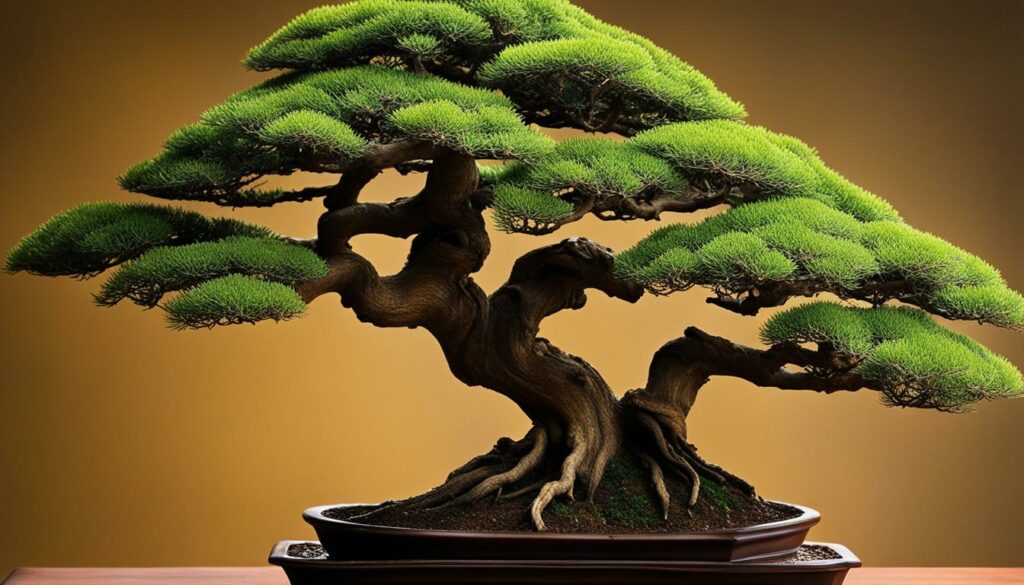
Care Essentials for Chinese Elm Bonsai
Proper care is vital for the optimal growth and health of your Chinese Elm bonsai. Consider the following essential care guidelines:
| Aspect | Guideline |
|---|---|
| Watering | The Chinese Elm requires consistent watering to prevent the soil from drying out and damaging the roots. Water your bonsai generously, but ensure that the soil is not waterlogged. Use a well-draining soil mix and never let your bonsai sit in standing water. Test the moisture level of the soil regularly and adjust watering frequency accordingly. |
| Sunlight | The Chinese Elm prefers bright, indirect sunlight but can also tolerate partial shade. Avoid exposing your bonsai to direct sunlight for extended periods, particularly during the hottest hours of the day. |
| Pruning | Pruning is essential for shaping your Chinese Elm bonsai and maintaining its size. Use sharp, clean pruning shears to remove any dead, damaged, or diseased branches. Regular pruning will also stimulate growth and promote vibrant foliage. |
| Soil | The Chinese Elm thrives in well-draining, nutrient-rich soil. A mixture of Akadama, pumice, and lava rock is an excellent choice for the soil mix. Repot your bonsai every two to three years to encourage healthy root growth. |
By following these care essentials, you can ensure the optimal growth and health of your Chinese Elm bonsai. Remember to monitor your bonsai regularly for any signs of pests or diseases and take immediate action if necessary.
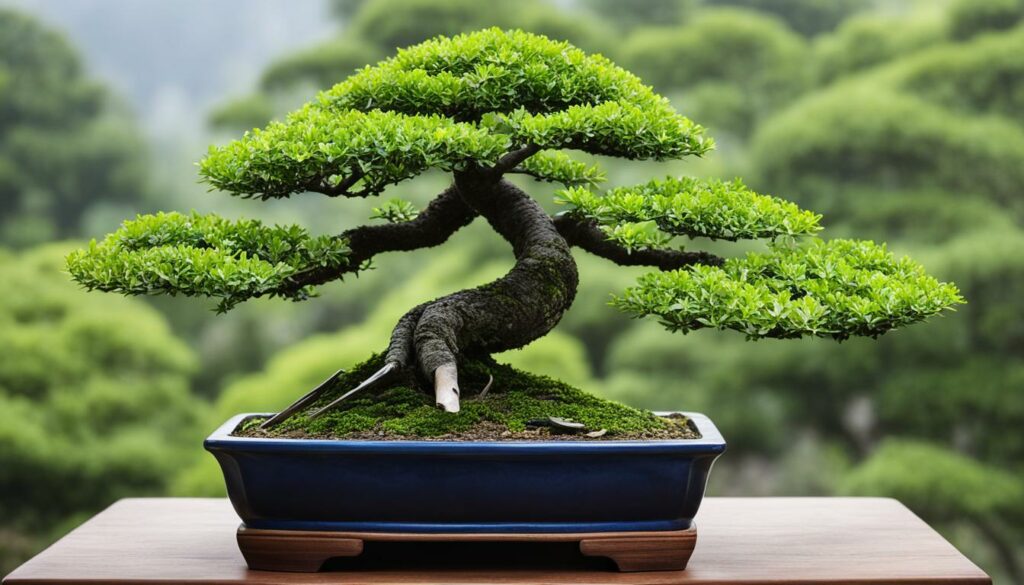
Pruning and Shaping Techniques for Chinese Elm Bonsai
Pruning and shaping are crucial processes in maintaining a healthy and aesthetically pleasing Chinese Elm bonsai. Regular pruning removes dead or excess growth and encourages new growth to develop, while shaping helps create the desired form and style.
When working with Chinese Elm bonsai trees, it’s essential to use proper pruning techniques to avoid damaging the delicate branches and foliage. Start by using clean, sharp pruning shears to make clean cuts at a 45-degree angle, avoiding leaving a stub that can invite pests and diseases.
Another common technique for shaping Chinese Elm bonsai trees is wiring, which involves gently bending the branches into the desired position and attaching thin wires to hold them in place.
To achieve various traditional bonsai styles with your Chinese Elm, such as the informal upright or cascading style, it’s crucial to understand the principles of each style and apply them accordingly. For example, an informal upright bonsai should have a strong, vertical trunk that tapers at the top and is balanced with foliage.
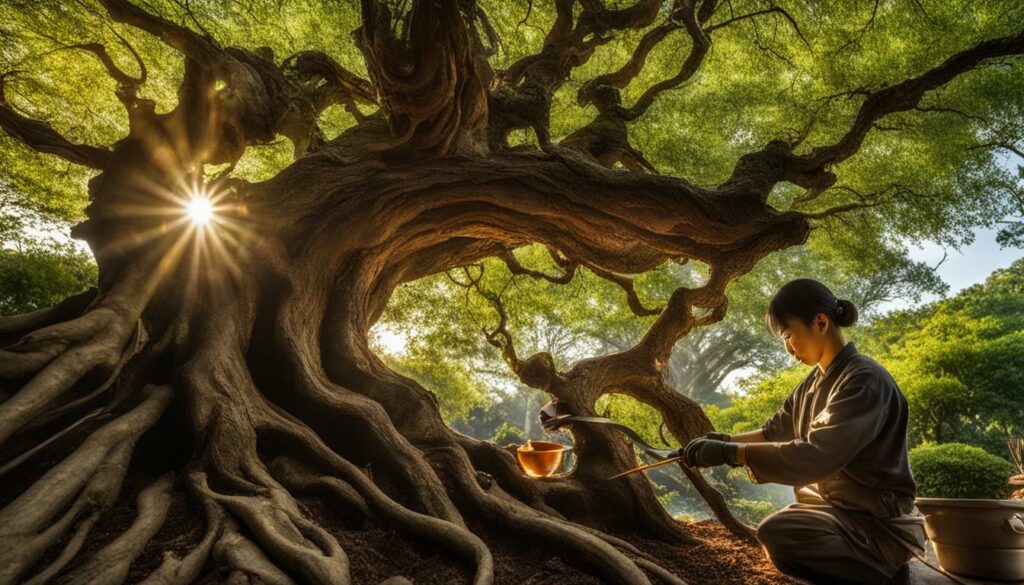
Pruning and Shaping Tips:
- Prune your Chinese Elm bonsai regularly, but avoid over-pruning, as this can weaken the tree.
- Use wire with caution, and be sure not to wire too tightly, as this can damage or kill the branches.
- Observe the natural growth patterns of your Chinese Elm bonsai and work with them to create a harmonious shape and style.
- Step back and evaluate your progress regularly, making adjustments as needed to achieve the desired form.
“Pruning is not just about controlling the growth of your Chinese Elm bonsai tree, it’s also about shaping it into a beautiful work of art.”
With proper pruning and shaping techniques, you can transform your Chinese Elm bonsai tree from a basic miniature tree to a stunning work of living art. Remember to always be patient and gentle, working with the natural growth patterns to achieve the desired shape and style.
Overcoming Common Challenges in Chinese Elm Bonsai Care
While Chinese Elm bonsai trees are known for their resilience, they are still susceptible to some common challenges that may impact their health and aesthetics. By understanding and addressing these issues promptly, you can ensure that your bonsai thrives.
Pests
Pests such as spider mites, scale insects, and caterpillars can all infest Chinese Elm bonsai trees. To prevent and manage infestations, regularly inspect your bonsai for signs of pests, such as fine webbing, sticky residue, or damaged foliage. You can wash away small infestations with a strong stream of water or treat the tree with an insecticidal soap.
Diseases
Chinese Elm bonsai trees can be affected by several diseases, including root rot, leaf spot, and powdery mildew. Proper watering and soil drainage, as well as removing infected leaves promptly, can help prevent the spread of disease. If the problem persists, consider contacting a plant pathology expert for guidance on treatment options.
Environmental Factors
Chinese Elm bonsai trees can also be impacted by environmental factors such as temperature changes, humidity fluctuations, and inadequate sunlight. To address these issues, ensure your bonsai is located in an appropriate environment with sufficient light, good airflow, and consistent temperatures and humidity. Consider using a humidity tray or a humidifier to increase humidity levels.
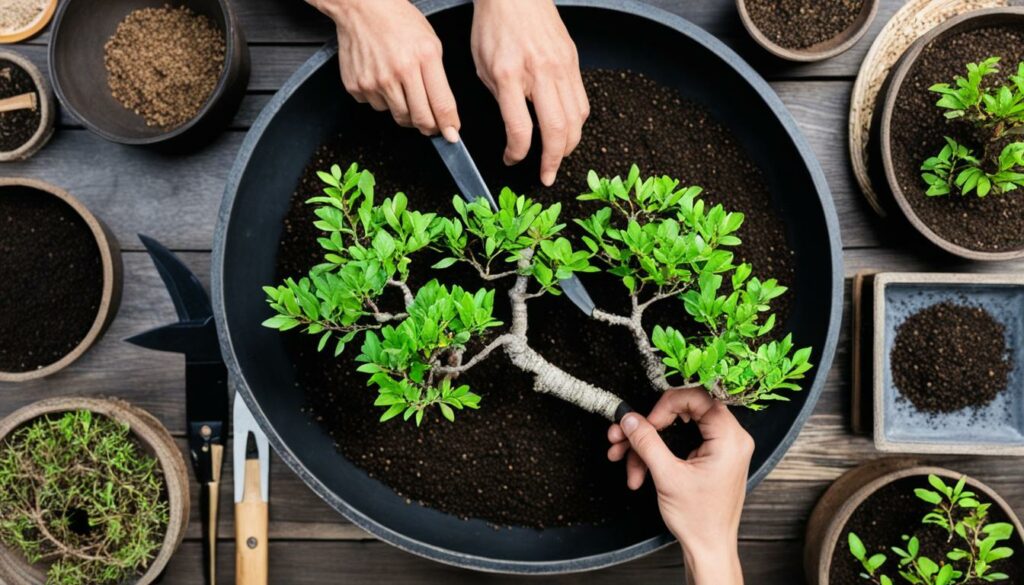
Chinese Elm Bonsai Display and Aesthetics
Displaying your Chinese Elm bonsai tree is an art form that requires attention to detail and a careful eye for aesthetics. A beautiful display can enhance the allure of your bonsai tree and create a stunning focal point in any room or garden.
One key element to consider when displaying your Chinese Elm bonsai is the pot. The pot should complement the tree’s shape and size while also adding to the overall aesthetics of the display. Consider using a glazed or unglazed ceramic pot that complements the tree’s color and texture.
The display stand is another important aspect to consider. Choose a stand that elevates your bonsai and provides a sturdy base for the pot. You can choose a traditional wooden stand in natural or painted finish or a more modern metal or glass stand for a contemporary touch.
When it comes to the overall aesthetics of your Chinese Elm bonsai display, consider the principles of composition and balance. Experiment with different angles and positions until you find the perfect arrangement. Keep in mind that simplicity and minimalism often create the most impactful displays.
“A well-displayed Chinese Elm bonsai tree can be a work of art that inspires awe and admiration.”
Tips for a stunning Chinese Elm bonsai display
- Choose a pot that complements the tree’s shape, size, and color.
- Select a sturdy and aesthetically pleasing display stand.
- Experiment with different angles and positions until you find the perfect arrangement.
- Embrace simplicity and minimalism for maximum impact.
Conclusion
The Chinese Elm is a beautiful and resilient bonsai tree species that can be enjoyed in any home or garden. By following the care essentials, pruning techniques, and overcoming any challenges that might arise, you can create a thriving miniature masterpiece.
Remember that the Chinese Elm, also known as Ulmus parvifolia, is a deciduous bonsai tree that offers stunning seasonal changes and should be cared for accordingly. Regular pruning and shaping techniques can help achieve the desired traditional bonsai styles.
As you embark on your bonsai journey, keep in mind that caring for the Chinese Elm requires patience, dedication, and a keen eye for aesthetics. By choosing suitable pots, display stands, and presenting your bonsai in a visually pleasing manner, you can enhance its overall allure.
Overall, the Chinese Elm bonsai tree species is an excellent choice for beginners and experienced cultivators alike. Whether you’re looking to add a unique touch to your home decor or embracing the art of bonsai cultivation, the Chinese Elm is sure to impress. Take care of your bonsai and watch it thrive, bringing joy and beauty to your life for years to come.
FAQ
What is the Chinese Elm bonsai tree species?
The Chinese Elm bonsai tree, scientifically known as Ulmus parvifolia, is a resilient and hardy species that is highly sought after in the world of bonsai cultivation.
Why is the Chinese Elm bonsai tree popular?
The Chinese Elm bonsai tree is popular due to its remarkable ability to adapt to various environments and its unique aesthetic appeal with its beautiful, textured bark and stunning seasonal changes.
Where did the Chinese Elm bonsai tree originate from?
The Chinese Elm bonsai tree is native to China, Japan, Korea, and Vietnam, where it has been cultivated for centuries as a symbol of strength and endurance.
What are the care essentials for Chinese Elm bonsai?
The care essentials for Chinese Elm bonsai include regular watering to maintain soil moisture, providing ample sunlight, implementing proper pruning techniques, and using well-draining soil to support optimal growth and health.
How do you prune and shape a Chinese Elm bonsai tree?
Pruning and shaping a Chinese Elm bonsai tree involves regular trimming of branches, using wire to guide branch growth, and employing various bonsai styling techniques to create the desired aesthetic appearance.
What are some common challenges in Chinese Elm bonsai care?
Common challenges in Chinese Elm bonsai care include dealing with pests such as aphids and spider mites, managing diseases like powdery mildew, and addressing environmental factors such as temperature fluctuations and humidity levels.
How should a Chinese Elm bonsai be displayed?
Displaying a Chinese Elm bonsai can be done using suitable pots that complement its aesthetics, utilizing display stands to enhance its visual appeal, and incorporating elements such as rocks or accent plants to create a harmonious composition.
What is the significance of seasonal changes in a Chinese Elm bonsai?
The seasonal changes in a Chinese Elm bonsai, including the vibrant fall foliage and bare branches during winter, are highly valued in the art of bonsai cultivation as they reflect the ever-changing nature and delicate beauty of the tree.
